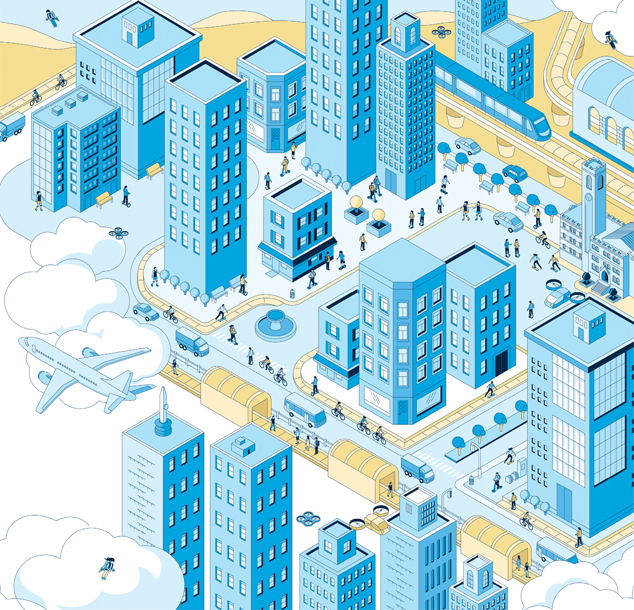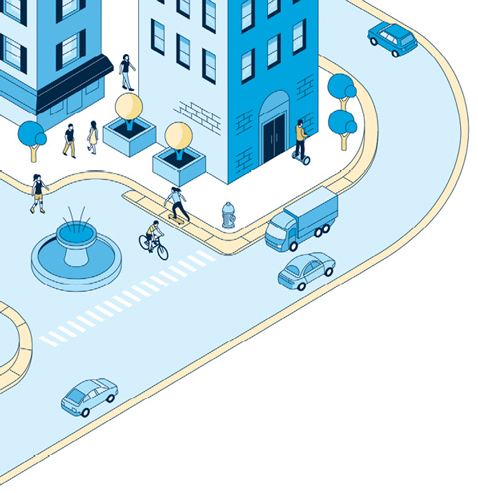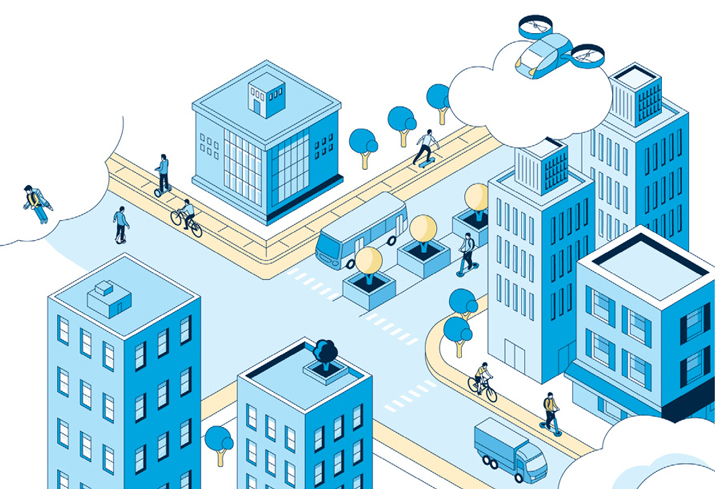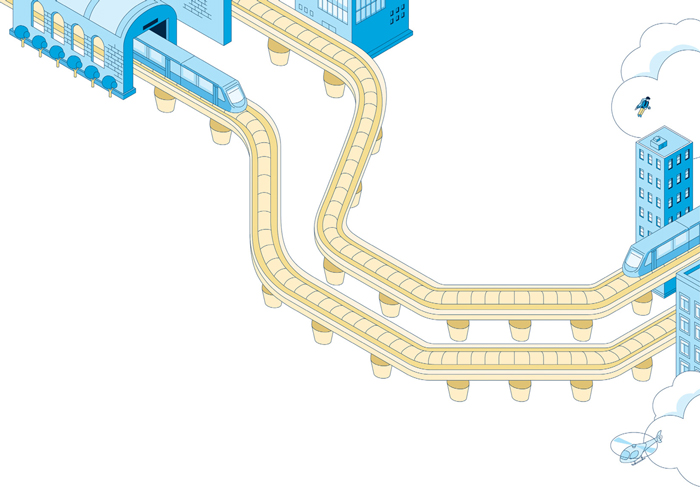By Stephen Ornes

To understand the current dismal state of transportation in many U.S. cities—if not around the world—one could do worse than to look at the events that unfolded in Nashville more than a year ago, around the first week of May 2018.
On the first day of that month, local voters torpedoed Let’s Move Nashville, an ambitious $5.8 billion, multidecade proposal to upgrade the city’s public transit network. Developed in response to the city’s swift growth and accompanying traffic headaches, Let’s Move rivaled the scope and budget of big-ticket transit remodels in expanding cities like Portland, Oregon, and Austin, Texas. It combined rapid bus lines with more than 26 miles of light rail and new areas for pedestrians and cyclists. The network centered on a 1.8-mile underground tunnel beneath downtown.
Erin Hafkenschiel, a 2008 Fulbright Scholar who studied urban planning and transportation in China, had been director of the Mayor’s Office of Transportation for two years at the time of the vote. During the Let’s Move campaign, she regularly heard objections from Nashvillians who insisted that emerging technology would solve the city’s traffic problems. “Lots of people were 100 percent convinced that in 10 years, all of our vehicles would be autonomous,” recalls Hafkenschiel, who in October 2018 left the mayor’s office to lead transportation and mobility initiatives at Vanderbilt. To see such a massive transformation that would take place so quickly was unrealistic, she says.

Autonomous vehicles won’t ease congestion anyway, she adds, and in fact could make things worse. “A car is a car, and cars take up a lot of space on our roads.”
Around the same time, other alternatives emerged as the transit plan foundered. The ideas ranged from introducing self-driving shuttles and double-decker interstates to exploring the feasibility of an aerial gondola like those found at ski resorts.
The Let’s Move referendum failed on a Tuesday, but something else happened later that week that continues to play a pivotal, if divisive, role in shaping conversations around transportation. On the following Saturday morning, without warning, a small startup based in Santa Monica, California, named Bird quietly deposited 150 electric, dockless scooters on the city’s streets—the first company to do so in Nashville. The failed vote, a flurry of proposals about new transportation alternatives, and the sudden introduction of electric scooters meant Hafkenschiel’s first week of May ended much differently from the way it had begun.
Almost overnight, the entire conversation had shifted dramatically.
MORE PEOPLE ON A CRUMBLING NETWORK
 The events that happened in Nashville in May 2018 are playing out in similar ways across many parts of the country, says civil engineer Will Barbour, a Vanderbilt Ph.D. student (and bicycle commuter) whose work focuses on how artificial intelligence and data-driven strategies can shape transportation. Many midsize cities are desperately searching for ways their growing ranks of citizens—facing longer commutes on crowded roadways—can move around safely and efficiently. Charlotte, North Carolina, has invested billions of dollars to expand its light rail line, and has plans for additions. Austin voters rejected a billion-dollar light rail plan in 2014, but they could be voting on a more expansive $10 billion system as early as next year. Most potential solutions come with massive price tags and years, if not decades, of disruptive construction.
The events that happened in Nashville in May 2018 are playing out in similar ways across many parts of the country, says civil engineer Will Barbour, a Vanderbilt Ph.D. student (and bicycle commuter) whose work focuses on how artificial intelligence and data-driven strategies can shape transportation. Many midsize cities are desperately searching for ways their growing ranks of citizens—facing longer commutes on crowded roadways—can move around safely and efficiently. Charlotte, North Carolina, has invested billions of dollars to expand its light rail line, and has plans for additions. Austin voters rejected a billion-dollar light rail plan in 2014, but they could be voting on a more expansive $10 billion system as early as next year. Most potential solutions come with massive price tags and years, if not decades, of disruptive construction.
The reason is that the transportation “issue” involves a multidisciplinary web of challenges from traffic pattern analysis and large-scale engineering projects, to climate change and politics. A long-term transportation solution requires taking stock of what people use now, what they could use in the future, what works, what doesn’t, and what’s falling apart.
That’s a heady challenge. “We’ve got to find more efficient ways to get people and goods served on these networks that are always in a constant state of disrepair and underfunded,” says Dan Work, associate professor of civil and environmental engineering, who researches new ways to integrate transportation with emerging technologies. “Transportation networks are aging. The number of people and amount of freight we’re trying to move from point A to B is increasing. We’re asking for real-time delivery of everything in two hours, or at least the next day. In addition to that, urban areas are densifying.”
Even when urban transportation networks are functioning well, our current systems are easily disturbed. Assistant Professor of Civil and Environmental Engineering and Littlejohn Dean’s Faculty Fellow Hiba Baroud and Assistant Professor of Computer Science Abhishek Dubey recently began investigating how major disruptions—due to inclement weather or special events—ripple through the city’s ever-more-congested transportation networks. Understanding those patterns isn’t just an academic exercise, Baroud says. Their research could have potential real-world impact.
“If you want to encourage people to use public transit, you want to make sure it’s reliable, efficient and safe,” she continues. “That’s what people care about. If they need an extra hour or two, it’s not efficient.”
The threat of climate change magnifies these day-to-day, pragmatic issues. Scientists warn that extreme weather events with the potential to disrupt transportation are likely to become more severe and more common. “Climate change is beginning to stress the system in ways that we’ve never seen before,” says Craig Philip, research professor of civil and environmental engineering and a longtime executive in the transportation industry, including 21 years as president and CEO of Ingram Barge Co. “We need creative new ways to deal with that.”
Today, Philip leads the Vanderbilt Center for Transportation and Operational Resiliency, or VECTOR, which was established
in 1988 to integrate academic inquiry and real-world applications. The center’s researchers face the daunting task of collecting and analyzing messy piles of data detailing how people get around, and turning that information into meaningful, useful solutions. Their projects range from analyzing barge and railway networks to predicting how connectivity and smart gadgets will reshape traffic.
Among the patterns they study, one of the most unpredictable is the weather. Research Associate Professor of Civil and Environmental Engineering Janey Camp says rising temperatures and record-breaking rainfalls demand new ways of thinking about infrastructure.
“We can’t continue to use the same designs for culverts and drainage systems that are going to remove water from our transportation infrastructure in the same way,” says Camp, who also serves as the associate director of VECTOR. Weather events are wreaking havoc on urban infrastructure locally and around the world. Last February, for example, heavy rains triggered a massive mudslide that closed I-24 between Nashville and Clarksville, Tennessee, for more than a month.
DRIVING TOWARD A SOLUTION
 One of the biggest challenges facing Nashville and many other U.S. cities is that they have been shaped in recent decades largely to accommodate automobiles. “We’re victims of our own success,” Philip says. “The automobile has been a phenomenally successful instrument for transportation, but, in communities across the country, Nashville included, we can’t keep up anymore. … We can’t build our way out of congestion.”
One of the biggest challenges facing Nashville and many other U.S. cities is that they have been shaped in recent decades largely to accommodate automobiles. “We’re victims of our own success,” Philip says. “The automobile has been a phenomenally successful instrument for transportation, but, in communities across the country, Nashville included, we can’t keep up anymore. … We can’t build our way out of congestion.”
Hafkenschiel says the same cars that have fueled explosive growth in cities like Nashville have also given rise to a kind of automotive tunnel vision. “If the only thing people know is their car, and that really is the only way to get around,” she says, “of course no one can imagine what a different future looks like.”
If building more roads won’t solve our current woes, what will? Autonomous vehicles may play a role, says Work, but only if we do it right.
In 2008 a team of physicists in Japan published the results of a remarkably simple study that continues to inform the way we think about traffic today. They wanted to know whether traffic jams occur spontaneously, even when there’s no obvious cause such as an accident, bottlenecks or a gonzo driver. So, they asked volunteers to drive around a 230-meter-long circular track at constant speed.
Footage from the trials was both revealing and infuriating. At first, the car line progresses evenly. But after just a few minutes, gaps open between cars. Some speed up, while others slam on the brakes. They cluster on one side of the circle; some cars almost crawl to a stop. Even under controlled circumstances, even without rush-hour anxiety, humans can’t help creating unnecessary traffic jams.
“One small mistake from one driver gets amplified by the driver behind, which then gets amplified further,” says Work. “By the time you see the car in front of you slow down, you brake, but you have to brake harder than the car in front of you to avoid running into them. And then we get stop-and-go traffic.”
In 2017 a quartet of engineers, each from a different university, decided to run an updated version of that experiment, but with a twist: What would happen if you added a self-driving car to the mix? Work, then at the University of Illinois, was one of the four researchers.
Jonathan Sprinkle, MS’00, PhD’03, an engineering professor at the University of Arizona and another co-investigator on the 2017 research, says he and his colleagues were eager to find out how technologies like self-driving cars could benefit all drivers on the road. “We wanted to know, what is the future of transportation?” he says.
In their experiment, 20 cars drove in a circle at a fixed speed, but one was equipped with self-driving features, including adaptive cruise control. It completely changed the story. Data from the experiments suggested that just one autonomous car could calm the unnecessary—phantom—jams that lurked within the ring of cars.
“If it’s designed in the right way, phantom jams go away with just 1 in 20 cars being automated,” says Work. But that’s a big if: Real-world roadways are much more complicated than a single-lane, circular track. Work also notes that autonomous cars haven’t been shown to decrease travel times or relieve congestion. “If you have 70,000 people trying to get out of downtown at six o’clock at night, it’s going to be congested whether they’re automated or not,” he says.
Work thinks it’s unlikely that self-driving cars will be the norm, rather than the exception, any time soon. “Forget 100 percent of cars being fully automated,” he says. The more interesting question may be how the integration of autonomous cars will affect existing transportation systems. “How few features can they have and still get rid of the jams caused by human drivers?”
Since he came to Vanderbilt, Work has run real-world experiments on eight commercially available cars with some autonomous features, such as adaptive cruise control or lane control.
“The gold standard is that an autonomous car would be a traffic jam dissipater,” he says. But that remains out of reach. His group has found that these vehicles, like unpredictable humans, sometimes cause unnecessary traffic jams. “They’re still jam amplifiers,” he says. “What we don’t know is whether they’re better or worse than humans.”
DISRUPTING THE LAST MILE
 Modern transportation is evolving as the result of three simultaneous revolutions: automation, electrification and sharing, says Work. At the intersection of all three are projects such as Work’s autonomous car experiments, self-driving taxis introduced in Arizona last December by Waymo (owned by Google’s parent company, Alphabet), and Tesla’s electric cars, which sport self-driving features.
Modern transportation is evolving as the result of three simultaneous revolutions: automation, electrification and sharing, says Work. At the intersection of all three are projects such as Work’s autonomous car experiments, self-driving taxis introduced in Arizona last December by Waymo (owned by Google’s parent company, Alphabet), and Tesla’s electric cars, which sport self-driving features.
In denser parts of Nashville—and Austin, Minneapolis, St. Louis, Charlotte, and an ever-growing list of other cities—the most visible disruption is the near ubiquity of those dockless electric scooters. They’re shareable, electric and cheap. Since the Saturday they first appeared, the vehicles have surged in number and divided cities across the nation and around the world. In Nashville, the most recent Metro Council elections even included one candidate whose entire platform was a pledge to ban scooters. Critics say they’re unsafe and a public nuisance that can pose real hazards for people with disabilities, not to mention the users themselves. In May 2019, a year after the scooters were introduced in Nashville, a rider died as a result of a scooter crash—and area hospitals have reported a spike in scooter-related traumatic brain injuries.
Yet, despite the dangers of scooters, they could help move the conversation about smart transit forward. Hafkenschiel, who was initially skeptical of scooters, now sees them as something else: a sign of an impending shift in thinking about how people get around, and a sign of things to come. “I have changed my tune,” she says. “The scooter question is a totally fascinating one.”
The bigger issue, she says, isn’t scooters. It’s short-distance trips. Cars, buses and light rail cover most typical journeys, but the last mile remains a formidable hurdle. Janey Camp, at VECTOR, knows this firsthand. “I’m a parent with two kids, and there’s no easy transit option to get them to school and me to my office,” she says. “Having a transit line nearby doesn’t necessarily enable parents with children or people with disabilities to actually utilize transit.”
That’s where micromobility—in the form of shared bikes, scooters, or even two-person go-karts that recently started zipping around downtown Nashville—comes in. Nearly half of all car trips are less than 3 miles long in the 50 most congested cities in the U.S., according to a recent study by research firm INRIX. “If it’s not scooters, it will be something else,” Hafkenschiel says. “There is such a demand for those shorter trips, particularly in cities like Nashville that don’t have good transportation systems.”
A few years ago, when Barbour began working on his doctorate, Vanderbilt hosted a fleet of shared ofo bikes. “This was before the scooter wars,” he says. One of his first projects was to analyze data to better understand how the Vanderbilt community used the bikes. “It revealed a lot about campus. What are the most popular routes? Where is most of the congestion occurring?”
The ofo bikes are long gone, but that analysis laid the groundwork for researchers like Barbour, and others at VECTOR, to study how people move on campus. Data from e-scooters could inform future changes to the way campus land is used in the FutureVU plan, for example. “We can improve walkability and bikeability on campus,” Barbour says.
The future of transportation, Camp and others say, won’t include just one mode, but instead many. Depending on your point of view, that’s either a welcome relief or a nightmare. “It’s going to take a buffet of options to really meet everyone’s needs,” she says. Light rail, fast buses, scooters and even those go-karts won’t solve the problems, but they’ll likely contribute to the evolution of a solution.
“The future is not that we’ll all be riding transit. Or all walking. We need multimodal transportation. Autonomous vehicles and technology will play a role, but we have to create more options. For us to solve our challenges, there isn’t one solution,” says Hafkenschiel. “But nobody wants to hear that. It makes it more complicated, and more time-consuming. All the options need to be on the table.”
Award-winning writer Stephen Ornes, a senior lecturer of communication of science and technology at Vanderbilt, earned master’s degrees from the University of Missouri and MIT’s graduate program in science writing. His latest book, Math Art: Truth, Beauty and Equations, was published in April.
Five Changes Helping People Move Around Campus and the City
Developed with leadership by Erin Hafkenschiel, Vanderbilt’s executive director for mobility, changes introduced at the beginning of the fall semester to improve transportation and mobility on campus are key to the university’s ongoing efforts through FutureVU to enhance the parklike character of the campus, connect its various neighborhoods, and align with the university’s goal to achieve carbon neutrality by 2050.
VandyRide
VandyRide, formerly Vandy Vans, now features two routes, faster service, more convenience and improved safety. In addition, four new sustainable, student-designed shelter stops will be installed around campus later this year. These changes are based on student feedback and additional study.
Ridehail Pick-up and Drop-off
Seven dedicated ridehail pick-up and drop-off locations have been designated around campus for services such as Uber and Lyft, in response to student requests to improve the safety of using such services.
Walk & Roll Loop
Construction is underway along portions of West End Avenue and 21st Avenue South on the first section of the Vanderbilt Walk & Roll Loop, a multiyear project that will enhance the mobility experience for students, staff and faculty as well as the surrounding community. The loop is a multimodal pathway envisioned to encircle the perimeter of campus. Recommendations from undergraduate students in the Vanderbilt Student Government Land Use Report inspired the loop idea. The Walk & Roll Loop is part of a defined greenway network planned for Vanderbilt, which will establish recognizable connections between places and spaces on campus. The loop will improve the pedestrian experience and allow for those using other modes of transportation, such as bicycles and other rolling devices, to navigate campus more easily.
Scooter and Bike Parking
Three scooter companies are currently approved to operate on campus: Bird, Lime and Spin. Scooter parking was created on campus last academic year, and this semester Vanderbilt staff are studying and making changes to scooter and bike parking in collaboration with the School of Engineering. These new parking options will feature improved signage and will provide additional locations, making the parking areas more visible in high-demand areas and helping to keep campus walkways and building entrances clear of scooters and accessible for all. Classes are offered by Vanderbilt University Public Safety (VUPS) to help those on scooters and bikes ride more safely. Learn more at vanderbilt.edu/futurevu/bikeshare.
Electric Golf Carts
New electric golf carts are available to provide rides for those with mobility or accessibility needs. This is a joint project between Student Access Services, VUPS, and the Transportation and Mobility Office.